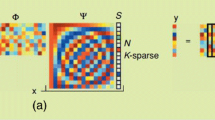Abstract
Steganography is a kind of technique which hides data under the cover file so as not to arouse any suspicion. In this paper, a new image steganography algorithm combining compressive sensing (CS) and random embedding is proposed. There are two security parts in this algorithm. The first part is the random projection inherited from CS, and the second is the random embedding process. CS serves to create the encrypted data, and acts as a tool to reduce the dimensionality of the secret data. Random-embedding algorithm is proposed to choose the position of cover image randomly for hiding the secret image. This algorithm uses symmetric key method, which means the sender and the receiver use the same key. Numerical experiments show that this steganography algorithm provides high embedding capacity and high Peak Signal Noise Ratio (PSNR).
Access this chapter
Tax calculation will be finalised at checkout
Purchases are for personal use only
Similar content being viewed by others
References
Amirtharajan, R., Rajesh, V., Archana, P., Rayappan, J.B.B.: Pixel indicates, standard deviates: a way for random image steganography. Res. J. Inf. Technol. 5(3), 383–392 (2013)
Bairagi, A.K., Mondal, S., Debnath, R.: A robust RGB channel based image steganography technique using a secret key. In: International Conference on Computer and Information Technology, Khulna, Bangladesh, pp. 81–87 (2014)
Banimelhem, O., Tawalbeh, L., Mowafi, M., Al-Batati, M.: A more secure image hiding scheme using pixel adjustment and genetic algorithm. Int. J. Inf. Secur. Priv. 7(3), 1–15 (2013)
Cands, E.J.: The restricted isometry property and its implications for compressed sensing. C. R. Math. 346(9), 589–592 (2008)
Chan, C.S., Chang, C.C., Hu, Y.C.: Image hiding scheme using modulus function and optimal substitution table. Pattern Recognit. Image Anal. 16(2), 208–217 (2006)
Chang, C.C., Nguyen, T.S., Lin, C.C.: Reversible image hiding for high image quality based on histogram shifting and local complexity. Int. J. Netw. Secur. 16(3), 208–220 (2014)
Donoho, D.L.: Compressed sensing. IEEE Trans. Inf. Theory 52(4), 1289–1306 (2006)
Hossain, S.M., Haider, M.: A hybrid method of data hiding into digital images. Dhaka Univ. Stud. Part B 55(2), 203–210 (2007)
Liu, X., Cao, Y., Lu, P., Lu, X., Li, Y.: Optical image encryption technique based on compressed sensing and Arnold transformation. Optik Int. J. Light Electron Opt. 124(24), 6590–6593 (2013)
Manoharan, S., Rajkumar, D.: Pixel value differencing method based on CMYK colour model. Int. J. Electron. Inf. Eng. 5 (2016)
Mondal, S., Debnath, R., Mondal, B.K.: An improved color image steganography technique in spatial domain. In: International Conference on Electrical and Computer Engineering, pp. 582–585. Dhaka, Bangladesh (2017)
Provos, N., Honeyman, P.: Hide and seek: An introduction to steganography. IEEE Secur. Priv. 1(3), 32–44 (2003)
Qaisar, S., Bilal, R.M., Iqbal, W., Naureen, M., Lee, S.: Compressive sensing: From theory to applications, a survey. J. Commun. Netw. 15(5), 443–456 (2013)
Rachlin, Y., Baron, D.: The secrecy of compressed sensing measurements. In: 2008 Allerton Conference on Communication, Control, and Computing, pp. 813–817. Urbana-Champaign, IL, USA (2008)
Rajendran, S., Doraipandian, M.: Chaotic map based random image steganography using LSB technique. Int. J. Netw. Secur. 19 (2017)
Romberg, J., Tao, T.: Exact signal reconstruction from highly incomplete frequency information. IEEE Trans. Inf. Theory 52(2), 489–509 (2006)
Singh, A., Singh, H.: An improved LSB based image Steganography technique for RGB images. In: IEEE International Conference on Electrical, Computer and Communication Technologies, pp. 1–4. Coimbatore, India (2015)
The USC-SIPI Image Database. http://sipi.usc.edu/database/. Accessed 28 April 2018
Wang, X., Zhao, J., Liu, H.: A new image encryption algorithm based on chaos. Opt. Commun. 285(5), 562–566 (2012)
Zhao, H., Ren, J.: Cognitive computation of compressed sensing for watermark signal measurement. Cognit. Comput. 8(2), 246–260 (2016)
Acknowledgements
This work was partly supported by the National Natural Science Foundation of China (61672008), Guangdong Provincial Application-oriented Technical Research and Development Special fund project (2016B010127006), the Natural Science Foundation of Guangdong Province (2016A030311013), and the Scientific and Technological Projects of Guangdong Province (2017A050501039).
Author information
Authors and Affiliations
Corresponding author
Editor information
Editors and Affiliations
Rights and permissions
Copyright information
© 2018 Springer Nature Switzerland AG
About this paper
Cite this paper
Xie, GL., Zhao, HM., Lv, JJ., Li, CY. (2018). A Reversible Data Hiding Scheme Using Compressive Sensing and Random Embedding. In: Ren, J., et al. Advances in Brain Inspired Cognitive Systems. BICS 2018. Lecture Notes in Computer Science(), vol 10989. Springer, Cham. https://doi.org/10.1007/978-3-030-00563-4_51
Download citation
DOI: https://doi.org/10.1007/978-3-030-00563-4_51
Published:
Publisher Name: Springer, Cham
Print ISBN: 978-3-030-00562-7
Online ISBN: 978-3-030-00563-4
eBook Packages: Computer ScienceComputer Science (R0)




